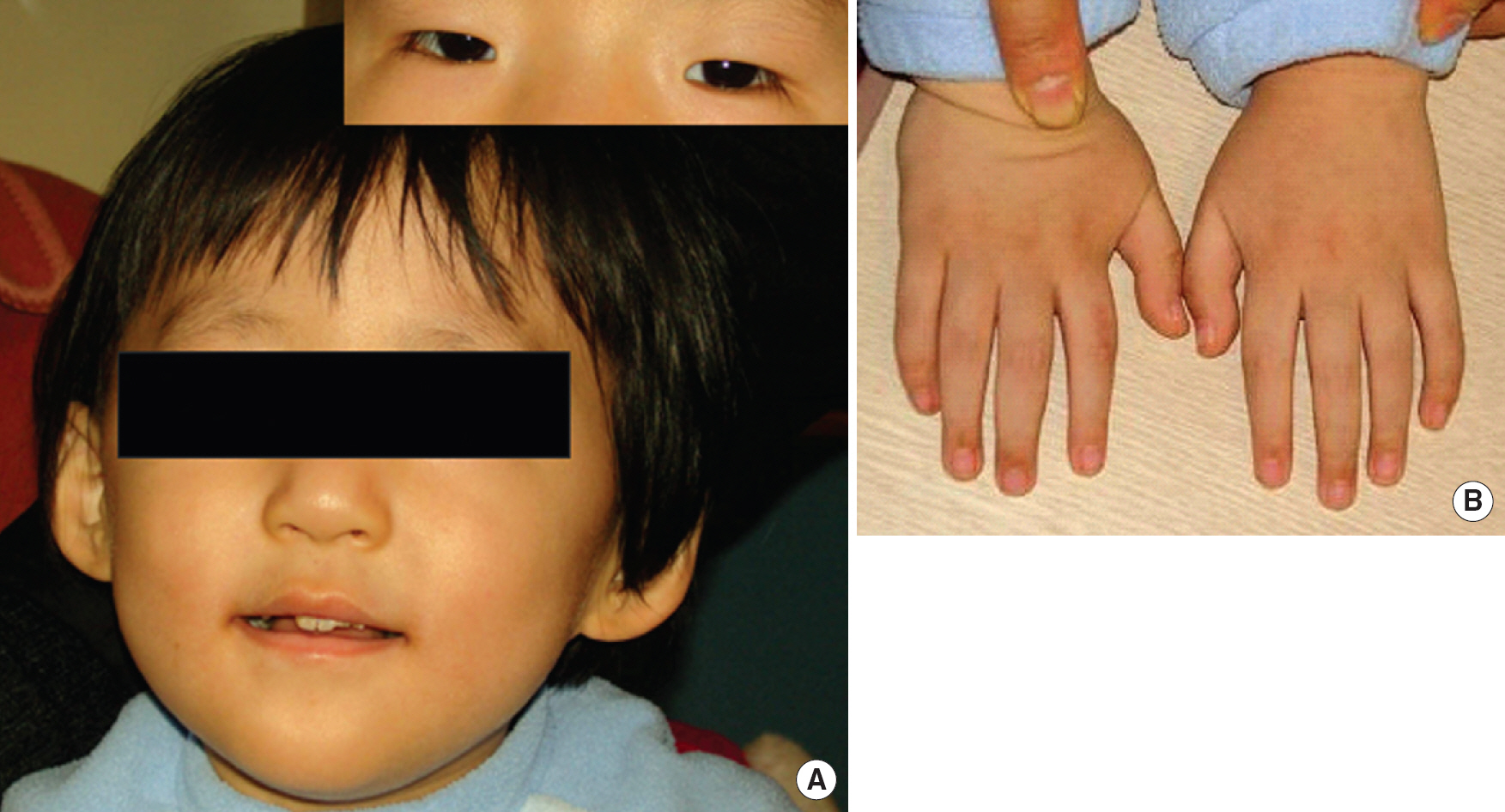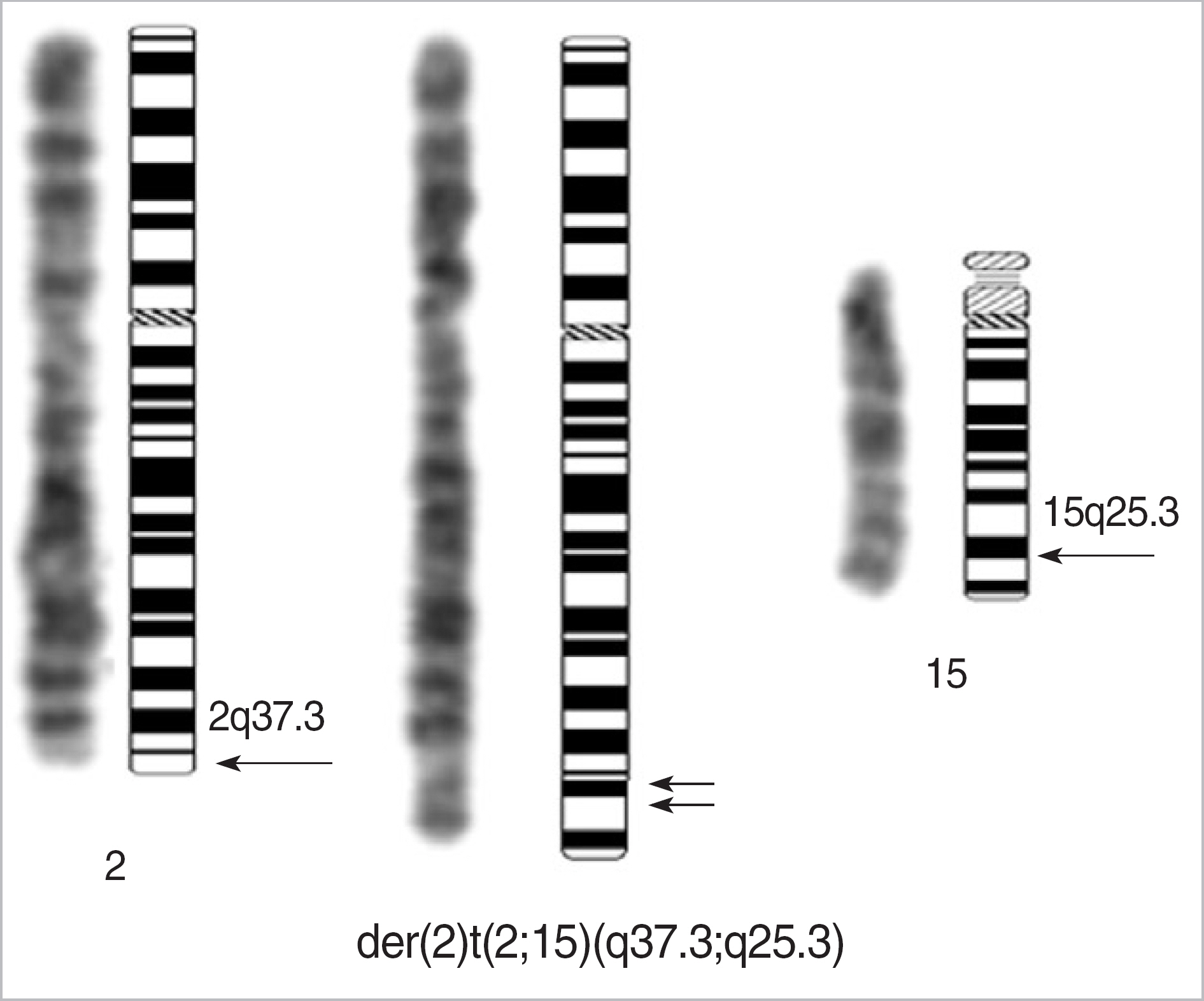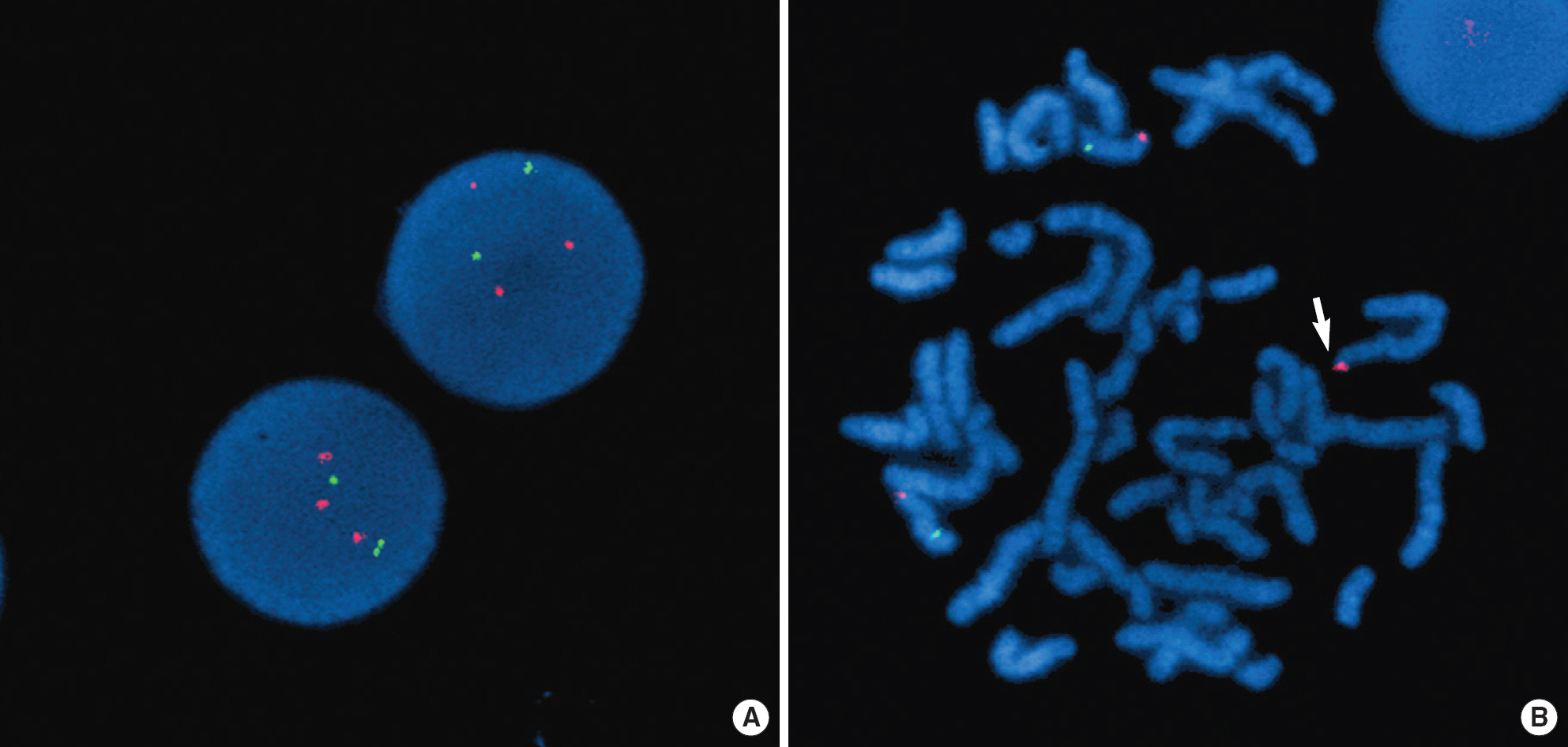Korean J Lab Med.
2009 Feb;29(1):66-70. 10.3343/kjlm.2009.29.1.66.
A Case of Partial Trisomy 15q25.3-qter
- Affiliations
-
- 1Department of Laboratory Medicine, Keimyung University School of Medicine, Daegu, Korea. ksksmom@dsmc.or.kr
- 2Department of Pediatrics, Keimyung University School of Medicine, Daegu, Korea.
- 3Department of Rehabilitation Medicine, Keimyung University School of Medicine, Daegu, Korea.
- KMID: 1781596
- DOI: http://doi.org/10.3343/kjlm.2009.29.1.66
Abstract
- A 15q25-qter partial trisomy characterized by pre or postnatal overgrowth, tall stature, macrocephaly and craniosynostosis has rarely been reported. The cause of overgrowth has been thought to be the triplication of the insulin-like growth factor 1 receptor (IGF1R) gene located on the 15q26.3. We report a patient with partial trisomy 15q25.3-qter showing mental retardation, developmental delay, macrocephaly, long narrow face, ptosis, high palate arch, scoliosis, clinodactyly and overgrowth. Additional material located on terminal 2q was found in karyotyping analysis. In bacterial artificial chromosome (BAC) clone-based-array comparative genomic hybridization (aCGH) analysis, a gain of 31 clones on 15q25.3-qter and a loss of 2 clones on 2q37.3 were observed. An extra copy of IGF1R gene was observed on derivative chromosome 2 in FISH analysis. In conclusion, the patient was diagnosed to have de novo 46,XX,der(2)t(2;15)(q37.3;q25.3) chromosome complement. Adequate genetic counseling and regular follow-ups would be needed for the patient.
MeSH Terms
Figure
Cited by 2 articles
-
The Prevalence and Genetic Pattern of Clinodactyly in Korean Populations
Duhyun Song, Junhyuk Chung, Hye-Gyeong Shin, Soo-Jung Jung, Jae-Ho Lee
Korean J Phys Anthropol. 2016;29(3):99-103. doi: 10.11637/kjpa.2016.29.3.99.A Girl with 15q Overgrowth Syndrome and dup(15)(q24q26.3) that Included Telomeric Sequences
María de los Ángeles Gutiérrez-Franco, María de la Luz Madariaga-Campos, Ana I. Vásquez-Velásquez, Esmeralda Matute, Guevara-Yáñez Roberto, Horacio Rivera
Korean J Lab Med. 2010;30(3):318-324. doi: 10.3343/kjlm.2010.30.3.318.
Reference
-
1.Zollino M., Tiziano F., Di Stefano C., Neri G. Partial duplication of the long arm of chromosome 15: confirmation of a causative role in craniosynostosis and definition of a 15q25-qter trisomy syndrome. Am J Med Genet. 1999. 87:391–4.
Article2.Nagai T., Shimokawa O., Harada N., Sakazume S., Ohashi H., Matsumoto N, et al. Postnatal overgrowth by 15q-trisomy and intrauterine growth retardation by 15q-monosomy due to familial translocation t (13;15): dosage effect of IGF1R? Am J Med Genet. 2002. 113:173–7.3.Faivre L., Gosset P., Cormier-Daire V., Odent S., Amiel J., Giurgea I, et al. Overgrowth and trisomy 15q26.1-qter including the IGF1 receptor gene: report of two families and review of the literature. Eur J Hum Genet. 2002. 10:699–706.
Article4.Faivre L., Rousseau T., Laurent N., Gosset P., Sanlaville D., Thauvin-Robinet C, et al. Prenatal overgrowth and mosaic trisomy 15q25-qter including the IGF1 receptor gene. Prenat Diagn. 2004. 24:393–5.
Article5.Roggenbuck JA., Mendelsohn NJ., Tenenholz B., Ladda RL., Fink JM. Duplication of the distal long arm of chromosome 15: report of three new patients and review of the literature. Am J Med Genet A. 2004. 126:398–402.
Article6.Partington MW., Fagan K., Soubjaki V., Turner G. Translocations involving 4p16.3 in three families: deletion causing the Pitt-Rogers-Danks syndrome and duplication resulting in a new overgrowth syndrome. J Med Genet. 1997. 34:719–28.
Article7.Elliott M., Maher ER. Beckwith-Wiedemann syndrome. J Med Genet. 1994. 31:560–4.
Article8.Faivre L., Viot G., Prieur M., Turleau C., Gosset P., Romana S, et al. Apparent Sotos syndrome (cerebral gigantism) in a child with trisomy 20p11.2-p12.1 mosaicism. Am J Med Genet. 2000. 91:273–6.
Article9.Baker J., Liu JP., Robertson EJ., Efstratiadis A. Role of insulin-like growth factors in embryonic and postnatal growth. Cell. 1993. 75:73–82.
Article10.Roback EW., Barakat AJ., Dev VG., Mbikay M., Chrétien M., Butler MG. An infant with deletion of the distal long arm of chromosome 15 (q26.1-qter) and loss of insulin-like growth factor 1 receptor gene. Am J Med Genet. 1991. 38:74–9.
Article11.Okubo Y., Siddle K., Firth H., O'Rahilly S., Wilson LC., Willatt L, et al. Cell proliferation activities on skin fibroblasts from a short child with absence of one copy of the type 1 insulin-like growth factor receptor (IGF1R) gene and a tall child with three copies of the IGF1R gene. J Clin Endocrinol Metab. 2003. 88:5981–8.
Article12.Shrimpton AE., Braddock BR., Thomson LL., Stein CK., Hoo JJ. Molecular delineation of deletions on 2q37.3 in three cases with an Albright hereditary osteodystrophy-like phenotype. Clin Genet. 2004. 66:537–44.
Article13.van Karnebeek CD., Koevoets C., Sluijter S., Bijlsma EK., Smeets DF., Redeker EJ, et al. Prospective screening for subtelomeric rearrangements in children with mental retardation of unknown aetiology: the Amsterdam experience. J Med Genet. 2002. 39:546–53.
Article14.Carret CK., Horrocks P., Konfortov B., Winzeler E., Qureshi M., New-bold C, et al. Microarray-based comparative genomic analyses of the human malaria parasite Plasmodium falciparum using Affymetrix arrays. Mol Biochem Parasitol. 2005. 144:177–86.
Article
- Full Text Links
- Actions
-
Cited
- CITED
-
- Close
- Share
- Similar articles
-
- A Case of Partial Monosomy 10q with Partial Trisomy 22q due to Maternal Balanced Translocation
- Partial Trisomy 2q(2q37.3->qter)and Monosomy 7q(7q34->qter) Due to Paternal Reciprocal Translocation 2;7: A Case Report
- A Cse of Partial Trisomy 10q Syndrome
- The clinical phenotype of the derivative (8)t(7;8)(q22;p23.3) in two siblings
- A Case of Distal 10q Partial Trisomy Syndrome





